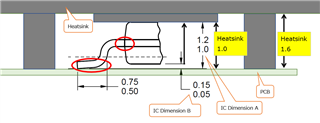Other Parts Discussed in Thread: TPA3255EVM, TPA3255
Hello Support team,
The TPA3255EVM uses the ATS-TI10P-519-C1-R3 heatsink.
The space where the IC is in close contact with the ATS-TI10P-519-C1-R3 is 1.00 mm.
However, the maximum height of the IC is 1.20mm.
The TPA3255EVM has a structure that puts stress on the IC.
Is there any problem with the same structure in mass production design?
TPA3255EVM User's Guide (ti.com)
ATS-TI10P-519-C1-R3.pdf (digikey.com)


Best Regards.
Kaz


